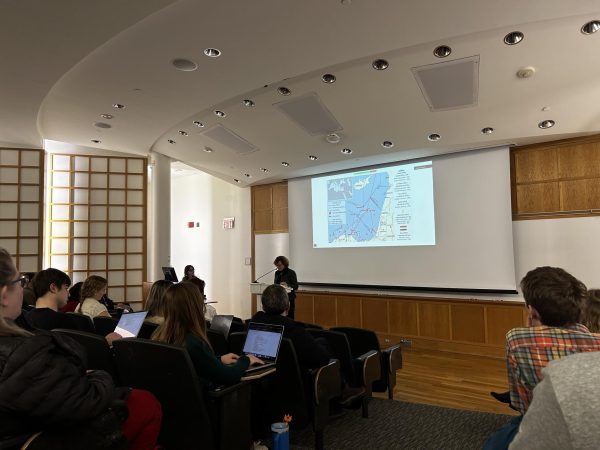Linzen Says Chill Out
Students and faculty crowded into the Henshaw Lecture Room in Lathrop Hall on Thursday afternoon to hear a controversial lecture by Massachusetts Institute of Technology Alfred P. Sloan Professor of Meteorology Richard Lindzen. Colgate Professor of Political Science, Presidential Scholar and Director of the Center for Freedom and Western Civilization Robert Kraynak, who introduced Lindzen, explained that the original title of the lecture had been “Global Warming: Science and Moral Responsibility” but that he and Lindzen had come up with a better one: “Global Warming: Who’s to Blame, Human Activities or Natural Causes?”
Lindzen is one of the most noted and prolific detractors from what Kraynak described as the “popular wisdom of global warming.” Lindzen began by saying that he had “always assumed that talking about the weather was a source of boredom.” He then began to explain his real concern that too much alarmism surrounds the topic of global climate change. His first goal: to debunk Al Gore.
He recalled that all schools in the United Kingdom had recently been required to show Gore’s film An Inconvenient Truth. He noted that a judge ruled that all presentations of the movie be accompanied by a presentation of critiques and explanations of some of the movie’s scientific exaggerations. Lindzen cited one of Gore’s statements in that film that a melting of the icecaps at either Greenland or West Antarctica would result in a sea level rise of 20 feet “in the near future.” The judge, according to Lindzen, said, “this remark was distinctly alarmist” and that Gore’s predicted result would take millennia to come about. Lindzen called Gore’s statement that “warming is real and caused by humans,” a “masterful example of creative ambiguity.”
“The points of agreement [on warming] have no discernable connection to the alarm,” Lindzen said. “If it turns out that we don’t have warming or that it is not due to man, that has implications that the association of alarm with greenhouse gas emissions is baseless.”
His next point questioned both the derivation and meaning of the popular model of the “hockey stick” graph of weather change, which shows a dramatic increase in temperature rise in recent history.
“Even if you call that [rise] unprecedented, it is still too small to suggest alarm,” Lindzen said.
After bringing up the scientific inaccuracies in inferences Gore drew from a different graph in his book, Lindzen moved to a different argument against the catastrophic consequences that some predict will come as a result of global warming.
“Any prediction of catastrophe is extremely unlikely,” Lindzen said. He cited the panic in the 1970s over the prediction of catastrophic American famine in the 1980s, which turned out to be false, as well as the infamous prediction of the Y2K disaster.
“These predictions of catastrophe come up episodically and they are always wrong because they have wrong linkages,” Lindzen said.
He then projected a model of the linkages leading from cause — carbon dioxide emissions — to effect — disastrous warming effects — in global warming and noted that the likelihood of each affecting the next was tiny, and that, in the end, the probability of any major effect of global warming was “astronomically small.”
Lindzen also brought up how the media has manipulated scientific fact and consensus to promote global warming.
He then went into a very scientific debunking of the sensitivity of climate to greenhouse gases, concluding that, “from a religious point-of-view, the Earth is well-designed.” He compared the attribution of global warming to greenhouse gases to the intelligent design theory.
“We can’t think of anything else, so there must be an intelligent designer,” he said.
“There is nothing happening in nature that suggests anything urgent,” Lindzen said. He then described all of the agendas of people who would be harmed “if you suddenly heard that there was no such thing as harmful global warming,” including the Nobel Prize Committee, which recently gave the Nobel Peace Prize to Al Gore, the environmental movement and science, alternative energy, the United Nations, trial lawyers “looking to make carbon the next tobacco” and individuals who have adopted this issue as a personal cause.
“The alarmist dogmas of the past 20 years are almost certainly false or misleading,” Lindzen said in conclusion.
A panel of three Colgate professors, Professor of Geography Adam Burnett, Assistant Professor of Chemistry Ephraim Woods and Professor of Economics and Environmental Studies Bob Turner were then allowed to ask Lindzen questions, followed by a question-and-answer session for students.
“I think it’s good to have folks on campus that have a strong point of view,” Woods said. “But [Lindzen] doesn’t engage in a discussion very well. He is very quick to reject some pieces of data as bad science or somehow contrived when they don’t meet with his point of view.”
“I thought that he made a very compelling argument,” first-year Mike Abrahamson, who attended the lecture on suggestion from a professor, said. “I would say as someone who knows very little about the science on either side that it was very convincing.”
“It’s nice that we now have viewpoints from both extreme sides of the issue,” first-year Alyssa Perez said, referring to the lecture and to The Weather Makers, the required reading for incoming first-years. “Now I’d like to hear from someone more in the middle of the issue.”
“I think this lecture helped a lot,”
Director of Summer Programs and Lecturer in University Studies Matt Leone, who suggested the lecture to his students, including Abrahamson and Perez, said. “Lindzen is an extraordinarily adept meteorologist. He is clearly very knowledgeable and passionate about his subject…This is the kind of thing that matters a lot…I can’t be convinced one way or another because I’m not a scientist, but I do feel as a citizen that I should do my best to understand the subject as best I can.”





